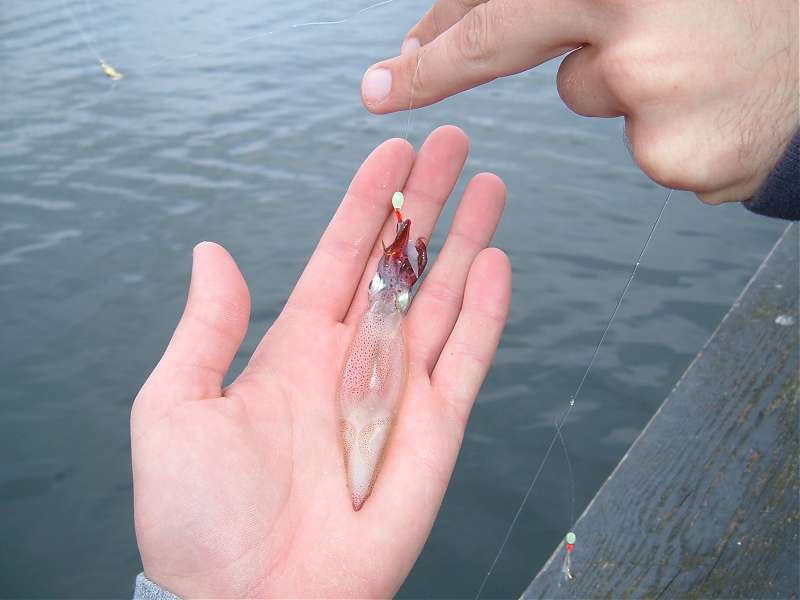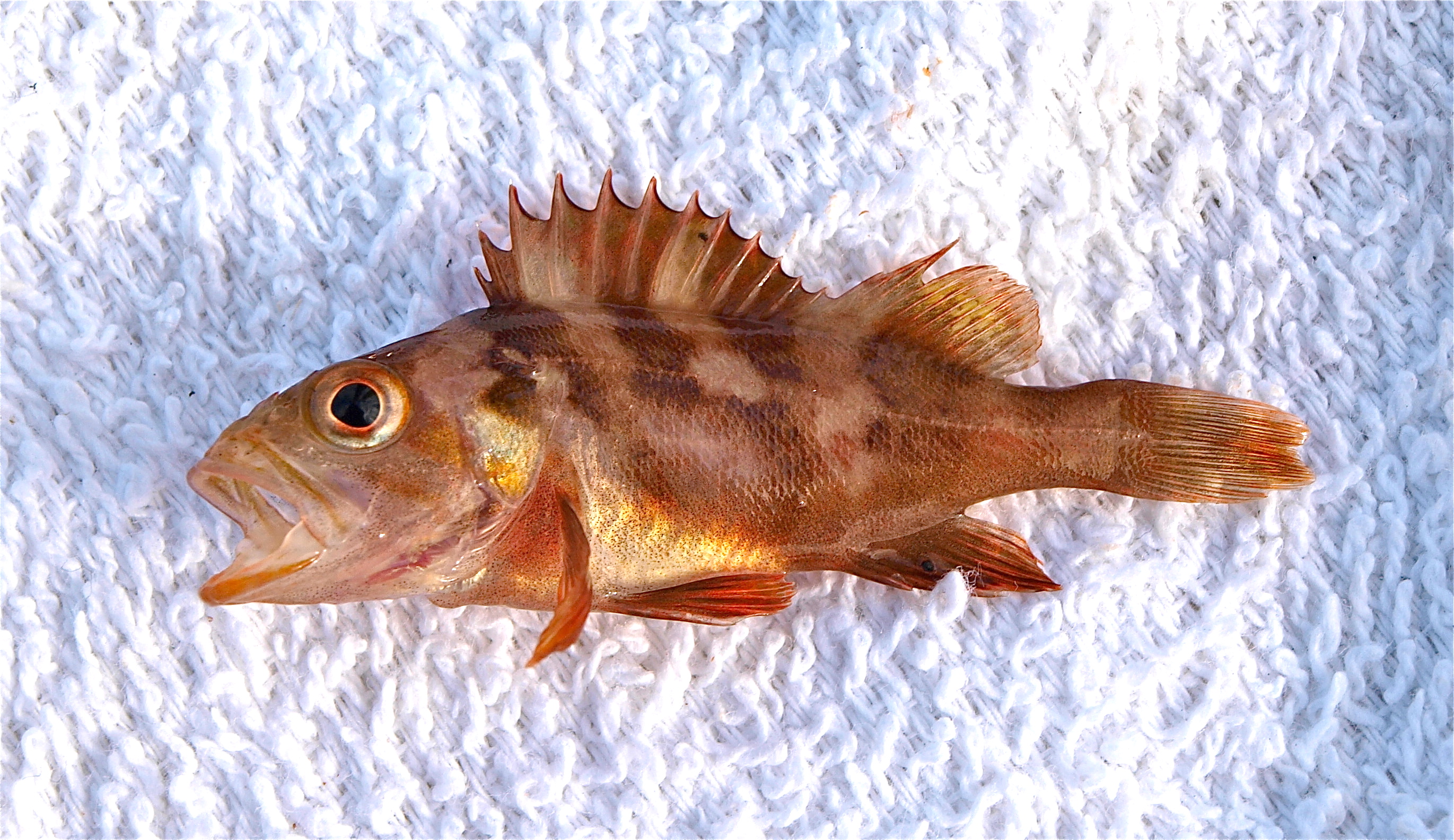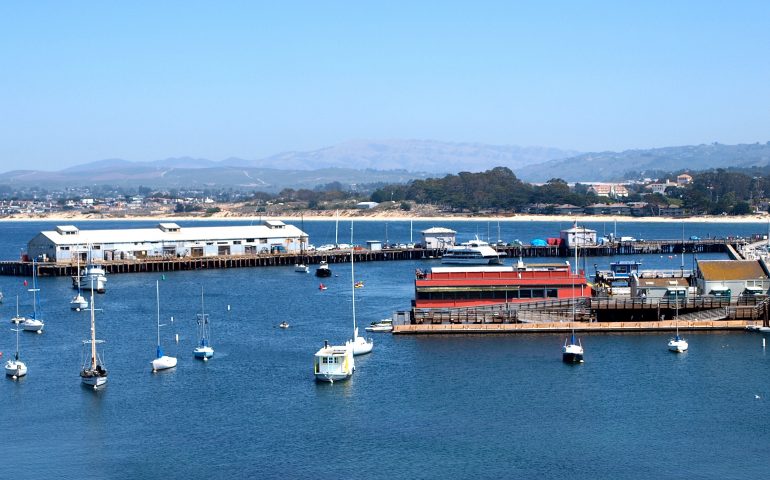Another visitor, although not as frequent now as in years past, is the common market squid (Loligo opalescens). When the squid schooled in the nearshore waters, anglers would flock to the pier at night and land buckets of the tasty little “calamari.” Generally this occurred mid-May to June, but the numbers seem to have decreased in recent years. However, TheEmptyBucket reported in May of ’06: “Squid were out again tonight at Wharf #2. Not as easy to catch as last night, though. Last night I was able to catch them on a Sabiki. Tonight I tried that for almost two hours while folks on either side of me were slaying them with squid jigs… One of the regulars took pity on me and loaned me a jig and then I started getting them almost immediately. A Sabiki with squid jig attached to the bottom was defiantly the way to go. I put about 40 3-5-inch squid in the freezer… Also had a blast.” Grammar police reported that same month: “FYI, Live squid being caught from the pier on Sabiki rigs. 5-8” range. RF candy for sure!” La mosca posted a note to the PFIC Board in July of ’08 that said: “about a month back, at sundown, I caught live squid, loads of them under and close to the wharf; could see them flashing their colors.” Sin_Coast reported in 2008, “We get ‘em [squid] off Monterey Wharf #2 consistently throughout the summer.” So the squid are still there, not just in the unbelievable numbers of past decades.

A small squid — picture provided by TheEmptyBucket
In addition, there’s the giant Humboldt squid that have become more prominent in California waters since the ‘90s. At least one giant squid was caught during March of 1998. The two-foot-long mollusk was caught on a lure by the startled angler. At the time, party boats were experiencing a good run of the 2-4-foot-long creatures out in deeper waters. Another non-fish, cephalopod species is octopus and just enough are caught to keep it interesting.
Lastly, you’ll see some people crabbing from the pier but I’ve never really noticed too many crabs being landed. Divers do report good numbers of sheep (spider) crabs hanging on the pilings but few seem to make it into the crab nets. Perhaps there are just too many sea otters and sea dogs in the vicinity for good crabbing.
Abalone Nursery — Kelp beds help rockfish population
There’s something fishy going on under Wharf 2. Art Seavey, co-owner of the Monterey Abalone Co., isn’t just growing expensive marine gastropods in the barrels and cages hanging from the pier scaffolding. He’s also helping researchers with their fish studies.
Young rockfish find shelter in and around the red abalone barrels, and oceanographer Jerry Norton of the National Oceanic and Atmospheric Association and marine biologist George Isaac of the Department of Fish and Game are monitoring their growth.
Rockfish, sometimes called Pacific red snapper, are a type of groundfish caught by bottom-trawling fishing boats; bocaccio is one of the familiar species. Rockfish have an uncommon trait for marine fish: They give birth to live young, rather than laying eggs. The larvae swim from deeper water to nutrient-rich nearshore areas like piers, where they feed on baby shrimp, crab eggs and other small fish.
“Down at the abalone farm they have those cages with kelp in them, and they make a very rich environment,” said Norton. “The fish take up residence around those cages.” Norton monitors the number of baby rockfish that make it from their birthplace in deeper water to the pier.
From 1970 to 1995, said Norton, the number of rockfish off the Central California coast had declined by 80 percent. “Some of them have become depleted because they haven’t found exactly the right conditions every year,” Norton said. But recent studies show rockfish might be making a comeback. “Beginning in about 1999, there’s been a turnaround in abundance, and we’ve seen much more at the abalone farm and around piers,” Norton said.
Norton thinks the recent increase in numbers of rockfish is due partly to the amount of nutrients along the Central California shore. Places like the Monterey Abalone Co. can play a part, providing the fish an endless buffet and a protected environment in which to grow. Workers at the Abalone Co. also help researchers track the number of fish that make it to shallow water each year… “Something that works out nicely is that when they pull up their cages to clean them and add food, they sometimes trap the little fish, and they save them for me,” said Norton. Isaac, of the Fish and Game Department, has also been studying rockfish collected from among the Monterey Abalone Co. barrels for the past three years. After he looked at several areas where he thought the baby fish might be abundant, he finally looked around the pier. “Sure enough, we found a lot of rockfish,” said Isaac.
Seavey has faced some criticism for his business, mainly from people who think kelp harvesting destroys sea otters’ homes. The Monterey Abalone Co. feeds its 200,000 abalone five tons of kelp from the Monterey Bay a week.
But kelp forests in the Monterey Bay are doing just fine, says one marine biologist. “If you cut the top of kelp, new fronds grow quickly to replace them,” said John O’Brien, who helps the Department of Fish and Game survey kelp forests on the California coast each year. Conditions in the Monterey Bay are highly favorable to kelp growth, he said. “You probably can’t harvest it fast enough to affect its growth.”
The abalone farm has served as a home to other marine creatures over the years. In addition to rockfish, Seavey has seen shrimp, octopuses and lobsters that are far out of their range in the abalone barrels. But Seavey sees so much abalone that he rarely even eats them anymore. “When I go home, the last thing I want to see is an abalone,” he said.
—Elisabeth Nadin, Monterey Hearald, February 8, 2003

A juvenile copper rockfish taken in 2015
The Pier Rats Speak
Date: March 2, 1999; To: Pier Fishing In California Message Board; From: Calder Deyerle; Subject: Monterey Wharf #2
The things that we are catching at the wharf are a few steelhead and a few jacksmelt. I have also seen a couple of perch.
Date: April 16, 2001; To: PFIC Message Board; From: avidangler; Subject: Monterey Wharf #2
The perch have arrived. Today I saw the first large school of perch under the wharf near the fuel dock (midsection). There were lots of silvers and pileperch, so out came the rod and away I went! The tide was coming up (it was 3:00) and I tied on a 1/3-ounce jighead with a motor oil perch grub. I caught a large rainbow, three rubberlips (one was around 2 lbs), several pileperch, and a few silvers. I had never seen pileperch so aggressively hit artificial grubs like they did today. They swarmed it. My pal James was getting them on a bubble gum pink grub, although not as many. Motor oil was the ticket. Should be many, many perch in the next few months. Those rubberlips are tricky to land on four-pound line near the pilings!
Date: September 30, 2001; To: PFIC Message Board; From: steelhead; Subject: Monterey salmon “on fire”
Hello everyone, this message might be a little late… but I have to post it anyway. The salmon have arrived in large numbers off the Monterey pier. And I mean LARGE NUMBERS. Schools of 30-40 salmon cruising back and forth in front of the pier. Some of the regulars were catching 20-25 salmon a day in just 5 feet of water. Myself, I caught 6 in just two hours. The salmon came in right after the big thunderstorm we had last week. Since then it has been non-stop action. The bad part is that salmon season ends today… so get down there today if you can. Steelhead
Posted by jason chin
Treble hooks with a feather does not count. Jason “bayrunner”
Date: May 4, 2002; To: PFIC Message Board; From: avidangler; Subject: Monterey Wharf #2
James and I fished the pier at around nine this morning for perch. We fished under the pier around midway with pile worms on a 1/32-ounce leadhead and caught and released around 35 or so rainbow seaperch and pile perch on ultra light tackle. There are many silvers also but I only landed one of those, as they were being finicky. Not much else happening pier wise save for a few small smelt here and there. -avidangler
Date: July 25, 2002; To: PFIC Message Board; From: avidangler; Subject: Re: Leapin, what’s “lining?”
You all know I’m from Monterey and fish the Wharf #2 regularly. I was not present on this particular day in question because I have bills to pay, so I saw no such incident of snagging with a bare hook. In notsosmart’s post, the fish was foul hooked with a bare hook. That is snagging. You must use a lure to catch a game fish, or bait. Period.
Lining is a method in which one uses a long leader and a bead or yarn to hook salmon or other fish in the mouth. Whether it is voluntary or not depends on the fish. Salmon will hit yarn, and they will also hit a bead. The majority of fish hooked on the rivers I have fished while people were using this method were involuntarily hooked, many in the mouth, some in the head, others in the back or tail. The wardens I have talked to say that if the fish swims off with your line and it is mouth hooked it is legal. Period.
Now for avidangler’s stance on “lining” and “snagging” at Wharf #2. I will NOT snag fish period! The fine is like a thousand dollars, it is hectic fishing, and frankly I will legally hook many more fish than the average snagging moron. Salmon come to Wharf #2. Why? They are planted in the harbor as fingerlings and allowed to mature to smolt size. They return to the “river” of their origin, which is the harbor. These fish turn dark in saltwater and die. They do not reproduce. We have asked the DFG to extend the season so that less of these fish will be wasted, due to the fact that the return usually peaks after ocean salmon season is closed. Our requests have fallen upon deaf ears.
The DFG is fully aware of last year’s snagging problems and many anglers were issued citations as a result. This year we shall see what happens with the snaggers. So far I have seen anglers throwing spoons and lining fish so as far as notsosmart’s report of snagging I cannot confirm this.
The DFG is allowing lining of these salmon. You know what I say? Why not? These fish are going to either get eaten by harborbags and sea lions (go there at night and watch the gauntlet!) or die and get picked at by seagulls and crabs. The sole purpose of these fish is to boost sport catch. I would like to see them not go to waste myself. If that means people line rub them, by all means why not. After the sea lions get them all fidgety they will not readily strike bait or artificials, although I know a few tricks (heh heh). Better that people get some sport and some dinner. If the law allows it, that’s the bottom line. The practice will continue. There will be some bad apples in every crowd. Avoid them.
Date: September 14, 2002; To: PFIC Message Board; From: avidangler; Subject: Monterey Wharf
The salmon action has been good. My pal Frank hooked a beauty off the beach adjacent to the pier on a #6 Blue Fox spinner this morning. I just finished eating some of that fish a little while ago. Last week the same Frank got a twenty-four ponder on same said spinner, and yesterday my pal Orby nailed a 34 pound, 1 oz fish on pink yarn. No joke. He did well to land that pig!!
Date: October 26, 2006; To: PFIC Message Board; From: pinoy; Subject: Plenty of bat rays in Monterey!
They have been catching bat rays at the wharf for a few nights now. Finally, I had a chance to try it last night. I was using an Eagle Claw “Surf Beast” 10ft rod, Okuma AV80, 80-lb spiderline (25-lb diameter), steel leaders topped with 2/0 hooks, and squid bait. I started fishing at 7pm and first 20 minutes was slow for me although everyone else seems to be catching bat rays left and right. Boredom was followed by some teasing from my pregnant wife. She said that if she’s not pregnant and have strength to fight the rays, she would have been catching after a few minutes of casting out. She said I have until this time next year to hold the family record on bat ray catch even if I catch the tiniest one in the bay. She already beat me in the MF eel department. Hehehe!

[…] The floating docks of Monterey Harbor and the pilings beneath Municipal Wharf II provide a rich and diverse community created largely by human activity. via […]